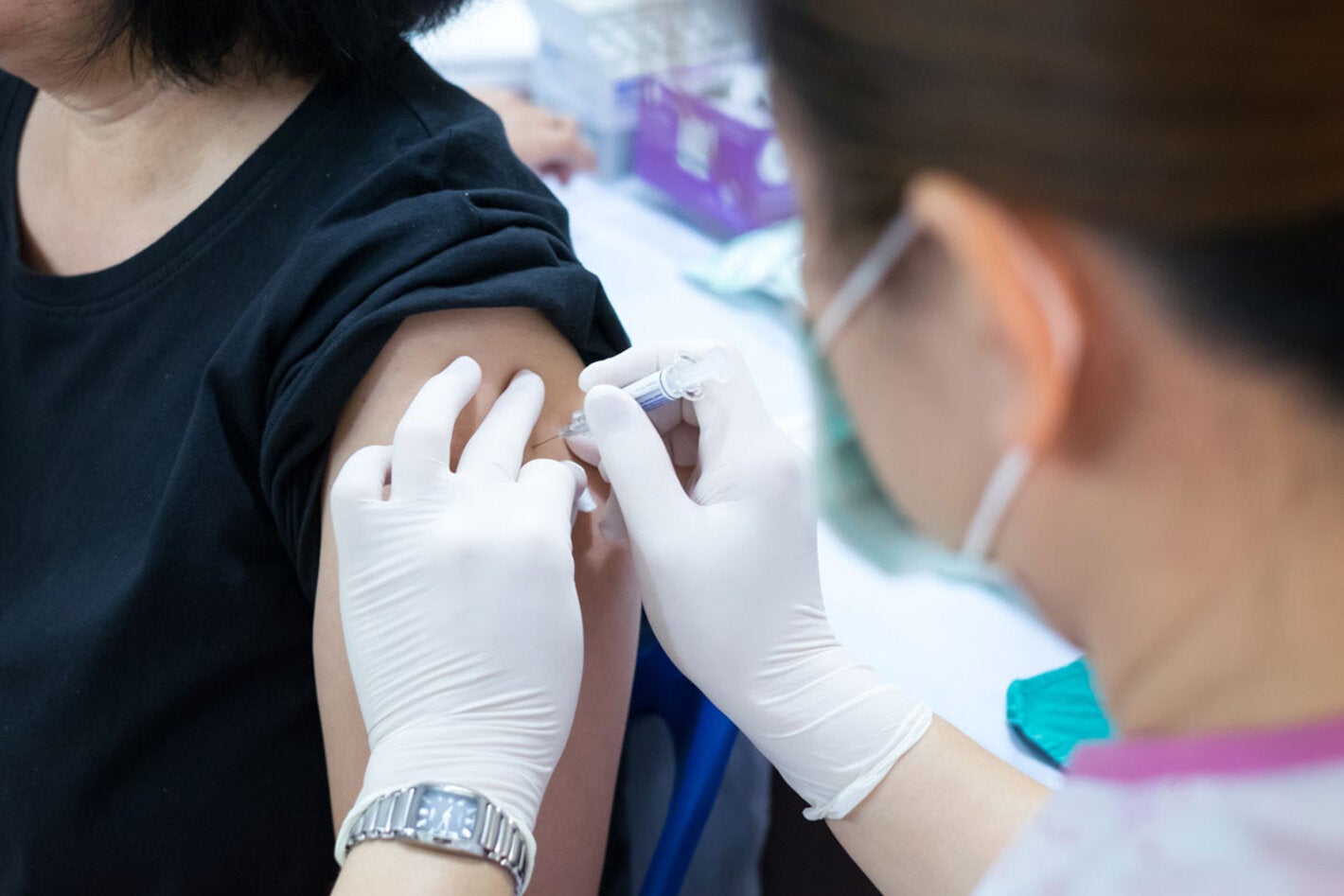
What is influenza? How does it spread? How can it be prevented? Get answers to these and other questions here.
Washington, D.C., 28 January 2015 (PAHO/WHO) — The influenza season is well under way in the Northern Hemisphere, sickening thousands of people, in some cases severely enough to result in hospitalization or even death. Below are questions and answers about seasonal "flu" and how to prevent and treat it.
What is influenza?
Influenza ("the flu") is a contagious respiratory illness caused by influenza viruses that infect the nose, throat, and lungs. It can cause mild to severe illness, and at times can lead to death. The best way to prevent the flu is by getting an influenza vaccine each year.
There are three types of influenza viruses: influenza A, B and C. Human influenza A and B viruses cause seasonal epidemics. Influenza A viruses are divided into subtypes based on surface proteins. Currently influenza A(H1N1) and A(H3N2) are the circulating subtypes, with a predominance of influenza A(H3) in Canada, Mexico, and the United States. Influenza B viruses are not divided into subtypes, but can be further broken down into different strains. Influenza type C infections cause mild respiratory illness and are not thought to cause epidemics. Influenza viruses are constantly changing, so it's not unusual for new virus strains to appear each year. The emergence of a new and very different ("novel") influenza virus can cause an influenza pandemic.
Who can get influenza?
Anyone, including healthy people, can get the flu, and people of any age can develop serious problems related to flu. However, some people are at higher risk of developing serious complications. These include people 65 years and older, people with certain chronic medical conditions (such as asthma, diabetes, or heart disease), pregnant women, and young children.
When is influenza activity highest?
Although influenza epidemics occur yearly, the timing, severity, and length of the season vary from year to year. In temperate regions, influenza activity is highest in autumn and winter. In the Northern Hemisphere, the season is generally from October to May, with peak activity in January or February, whereas in the Southern Hemisphere, it is generally from May to October, with peak activity in July or August. In some tropical countries, influenza viruses circulate throughout the year, with one or two peaks during rainy seasons.
What are the signs and symptoms of an influenza infection?
Typical flu symptoms include fever or feeling feverish/chills, cough, sore throat, runny or stuffy nose, muscle or body aches, headache and/or fatigue. Most people who get influenza will recover in a few days, but some will develop complications (e.g., bacterial pneumonia, ear or sinus infections, dehydration, and worsening of chronic medical conditions), some of which can be life-threatening.
How does influenza spread?
Most experts believe that flu viruses spread mainly when infected people cough, sneeze, or speak, and droplets come in contact with mouths or noses of people nearby. Less often, a person might also get flu by touching a surface or object that has flu virus on it and then touching their own mouth, eyes, or nose.
Most healthy adults with influenza may be able to infect others beginning one day before symptoms develop and up to 5 to 7 days after becoming sick. Some people, especially young children and people with weakened immune systems, might be able to infect others for an even longer time.
How can influenza infections be prevented?
The single best way to prevent seasonal flu is to get vaccinated each year (see also below), but good hygiene habits like covering your cough and washing your hands can help stop the spread of germs and prevent flu as well as other respiratory illnesses. Antiviral drugs are also available to treat and prevent the flu.
Good practices include the following:
- Avoid close contact with people who are sick.
- Stay home when you are sick.
- Cover your mouth and nose with a tissue when coughing or sneezing.
- Clean your hands. If soap and water are not available, use an alcohol-based hand rub.
- Avoid touching your eyes, nose, or mouth.
- Practice other good health habits: clean and disinfect frequently touched surfaces at home, work, or school, especially when someone is ill. Get plenty of sleep, be physically active, manage your stress, drink plenty of fluids, and eat nutritious food.
Is the vaccine an effective way to protect myself from influenza?
The most effective way to prevent influenza and its complications is vaccination. Safe and effective vaccines are available and have been used for more than 60 years. For healthy adults, influenza vaccine can provide reasonable protection. However, among the elderly, influenza vaccine may be less effective in preventing illness but may reduce the severity of disease and the incidence of complications and deaths.
Vaccination is especially important for people at higher risk of serious influenza complications and for people who live with or care for high-risk individuals.
PAHO/WHO recommends annual vaccination for:
- pregnant women at any stage of pregnancy
- children aged 6 months to 5 years
- elderly individuals (?65 years of age)
- individuals with chronic medical conditions
- healthcare workers.
Influenza vaccination is most effective when circulating viruses are well matched with vaccine viruses. Influenza viruses are constantly changing, and the WHO Global Influenza Surveillance and Response System (GISRS)—a partnership of National Influenza Centers around the world—monitors the influenza viruses circulating in humans.
For many years WHO has updated its recommendations on vaccine composition biannually, targeting the 3 (trivalent) most representative virus types in circulation (two subtypes of influenza A viruses and one B virus). Starting with the 2013-2014 Northern Hemisphere influenza season, quadrivalent vaccine composition has been recommended, with a second influenza B virus in addition to the viruses in the conventional trivalent vaccines. Quadrivalent influenza vaccines are expected to provide wider protection against influenza B virus infections.
Does this year's vaccine cover all the influenza viruses that are currently circulating?
The United States Centers for Disease Control and Prevention (US CDC) reported in January 16, 2015, a reduced influenza vaccine effectiveness (VE) in preventing medical visits associated with seasonal influenza illness and underscores the need for additional prevention and treatment efforts this season, including the appropriate use of influenza antiviral medications for treatment.
One factor that determines how well a flu vaccine works is the similarity between the flu viruses used in vaccine production and the flu viruses actually circulating. During seasons when vaccine viruses and circulating influenza viruses are well matched, VE between 50 and 60 percent has been observed. During this season H3N2 viruses have been predominant so far, but about 70 percent of them have been different or have "drifted" from the H3N2 vaccine virus. This likely account for the reduced VE.
Flu viruses change constantly and the drifted H3N2 viruses did not appear until after the vaccine composition for the Northern Hemisphere had been chosen.
Another factor that influences how well the flu vaccine works is the age and health status of the person being vaccinated. In general, the flu vaccine works best in young, healthy people and is less effective in people 65 and older. This pattern is reflected in the current season early estimates for VE against H3N2 viruses. VE against H3N2 viruses was highest -- 26 percent -- for children age 6 months through 17 years. While not statistically significant, VE estimates against H3N2 viruses for other age groups were 12 percent for ages 18 to 49 years and 14 percent for people age 50 years and older.
Flu vaccine is designed to protect against three or four influenza viruses and some of these other viruses may circulate later in the season. PAHO recommends that people get a flu vaccine even during season's when drifted viruses are circulating because vaccination can still prevent some infections and can reduce severe disease that can lead to hospitalization and death.
Will the same influenza vaccine be offered for the Southern Hemisphere?
The recommendations for the 2015 Southern Hemisphere influenza vaccine include A/Switzerland/9715293/2013 (H3N2)-like virus—the drifted H3 virus that is circulating in Canada and the United States.
What is PAHO/WHO doing?
PAHO/WHO, with its partners, monitors influenza regionally, recommends seasonal influenza vaccine compositions twice a year for the Northern and Southern hemispheres, and supports Member States' efforts to develop prevention and control strategies.
PAHO/WHO also works to increase vaccine coverage among high-risk groups and to strengthen national and regional influenza diagnostic capacities, antiviral susceptibility monitoring, disease surveillance, and outbreak response.
What does PAHO/WHO recommend?
The Pan American Health Organization is recommending that affected countries take the following actions:
- ensure appropriate clinical management for patients
- implement strict infection prevention and control measures in healthcare services
- ensure adequate supplies of antivirals
- continue vaccinating against influenza to reduce hospitalizations and prevent deaths.
For more information on the status of influenza and other respiratory viruses, consult the weekly Regional Update on Influenza in PAHO/WHO's Epidemiological Alerts and Reports.



